
The Retrogaming Times
- The Bimonthly Retrogaming Hobbyist
Newsletter -

The Retrogaming Times
- The Bimonthly Retrogaming Hobbyist
Newsletter -
|
It seems like only yesterday we began publication once again but here we are at the start of a third year since returning. I approach 2018 with what I believe is the slimmest video game collection I have had in over a decade. This is not only due to a focus of completing games and then moving onto others but also my personal move to flash memory based cartridges for the majority of my hardware. It honestly feels really good to cut down on some of the bulk while being able to experience new titles and fan-translations. For years it was thought by some that the mass proliferation of affordable flash memory cartridges would destroy the value of original physical video games but I can say, at least at the moment, that this couldn't be further from reality. The demand for retrogames continues to grow, regardless of how each individual may access them. How that may proceed into 2018 remains to be seen but I don't expect much change in that regard.
The new year is kicked off with Merman taking a look at several medical themed games for the Commodore 64 and beyond in More C64! After an issue away the Apple II Incider returns with Donald Lee looking back at his history with Star Wars games, including a modern project that utilizes classic hardware. NEC Electronics and Hudson Soft team up to release new hardware, known in North America as the TurboGrafx-16, and with it a new controller. Take a look at the early days of the system with Todd Friedman and The Controller Chronicles. New contributor Mateus Fedozzi recalls his first experiences with the Sega Master System and shares his favorite early games. Before TRON Legacy appeared on the sliver screen, a continuation of the original narrative was created as a computer game. Later enhanced and reworked for Xbox, TRON 2.0 Killer App promised first-person immersion in the world of the computer - and these expectations are put to the test in a new column, Classic Xbox. All that and more are ahead in this issue of The Retrogaming Times.
I want to again remind our readers if they
have comments or questions about anything covered in the newsletter, or
there is something they would like featured in a future issue of The Retrogaming
Times, to let us know via The Retrogaming Times on Facebook at facebook.com/theretrogamingtimes
or contact me directly at trt@classicplastic.net!
Of course submissions are also always open. If you have something
ready to go, the address is the same, trt@classicplastic.net. "If
there is something you want to write about, send it in!"
|
Midwest Gaming Classic, April 13th - 15th 2018, Milwaukee, Wisconsin, USA
The Midwest Gaming Classic is a trade show featuring 100,000+ square feet of retro and modern home video game consoles, pinball machines, arcade video games, computers, table top gaming, crane games, collectible card games and air hockey, and that's just the start.
The Midwest Gaming Classic is about celebrating gaming, trying new things, learning about the gaming hobby, about meeting others who share the love of gaming, and having fun doing it! No matter if you have one console and a handful of games or thousands of games in every room of your house, you'll find something to celebrate with us!
For more information, visit http://www.midwestgamingclassic.com/
~ ~ ~
ZapCon 6, April 21st - 22nd 2018, Mesa, Arizona, USA
ZapCon is a weekend-long classic arcade and pinball party, with all of the games set to free play! This sixth show will held at the Mesa Convention Center in Mesa, Arizona, April 21st - 22nd, 2018.
For more information, visit http://www.zapcon.com/
~ ~ ~
Pintastic Pinball & Game Room Expo, June 28th - 20th 2018, Sturbridge, Massachusetts, USA
Do you love pinball? Are you looking for a little relief from the hot summer sun? Look no further than Pintastic New England, which is the first of its kind, centrally located in Sturbridge, Massachusetts. This expo is 30,000 square feet of fun for the whole family. The kids can have never-ending excitement with a caricature artist, face painting, friendly clowns, balloon animals, yo yo and juggling show. The adults can bring out their inner child with over 200 pinball machines set on free play, all while enjoying an ice-cold craft beer.
For more information, visit https://pintasticnewengland.com/
~ ~ ~
KansasFest, July 17th - 22nd 2018, Kansas City, Missouri, USA
KansasFest is the world's only annual convention dedicated to the Apple II computer that revolutionized the personal computing industry. Held every year in Kansas City, Missouri, KansasFest offers Apple II users and retrocomputing enthusiasts the opportunity to engage in beginner and technical sessions, programming contests, exhibition halls, game tournaments, and camaraderie. Any and all Apple II users, fans, and friends are invited to attend this year's event.
Registration will open Spring 2018.
For more information, visit http://www.kansasfest.org/
~ ~ ~
ReplayFX, July 26th - 29th 2018, Pittsburgh, Pennsylvania, USA
Gamers behind the Replay Foundation & PAPA are taking over the David L. Lawrence Convention Center and filling it with more than 1,000 full-sized modern and classic arcade and pinball machines, over 2,000 retro console games playable on more than 250 console gaming stations dating from the 1970’s right up to the newest consoles like the XBox One, Nintendo Switch, and PS4, an entire section with dozens of tables dedicated to tabletop and board games, a showcase of new products by game developers, magicians, live musicians, balloon artists, face-painters, competitions offering over $110,000 in prize money, and more!
The Replay FX Arcade & Video Game Festival will feature the largest public collection of working pinball, arcade, tabletop, and console games anywhere in the solar system, and all games are free to play with the price of admission! Attendees are also invited to attend a series of seminars dedicated to gaming and its associated tech-culture, browse merchandise in the marketplace, watch the world's greatest pinball wizards compete in the Pinburgh Match-Play Championship, or enjoy a series of fun and wacky daily challenges at no additional cost!
Replay FX will include multiple live musical performances, a high-energy cosplay contest, inflatable obstacle courses, and more in a show floor packed with over a quarter-million square feet of entertainment! Over $110,000 will be at stake for the competitive player. Thousands of games will be available for the casual fan. A family-friendly atmosphere will be available for the kids, and no one has to leave the galaxy to attend!
For more information, visit https://replayfx.org/
~ ~ ~
California Extreme 2018, July 28th - 29th 2018, Santa Clara, California, USA
California Extreme is pleased to announce July 28-29, 2018 as our tentative dates for the 2018 California Extreme Arcade and Pinball Show. It will be held at the same fantastic location - the Hyatt Regency in Santa Clara, California. Please join us for our 22nd show with hundreds of your favorite arcade and pinball games, both past and present, all gathered together for another fun-filled weekend of pure arcade excitement for folks of all ages!
These dates are unfortunately the same weekend as ReplayFX. For this year, the conflict is unavoidable. There are a lot of constraints on us for available dates. July works best for our participants, and historically worked well as we have always sought to avoid conflict with other events. We truly regret this inconvenience.
Mark your calendars and we hope you can join us on July 28 - 29. We will announce later when dates are finalized and when the hotel will be accepting reservations.
For more information, visit http://www.caextreme.org/
~ ~ ~
Retropalooza, September 29th - 30th 2018, Arlington, Texas, USA
A celebration of all things retro! Retropalooza was started in 2013 in Arlington, Texas by a couple of guys who enjoy all things retro; from toys to music, to video games... especially video games. As video game collectors, they spent a lot of time and money looking for retro games when they figured it would be easier to bring the games to them. Thus, Retropalooza was born.
The goal of Retropalooza is to bring nerds from all walks of life together for an enjoyable, family friendly time. Good old fashioned fun with like minded people where it will always be affordable, and forever improving.
For more information, visit http://retropalooza.com/
~ ~ ~
If there is a show or event you would
like listed here, free of charge, please contact David directly at trt@classicplastic.net.
Please include a short official blurb about your event along with any relevant
links or contact information and it will be published in the next issue
of The Retrogaming Times. The event listing will remain posted until
the issue following the event date. Big or small, we want to promote
your show in our newsletter. Check out these great events, shows,
and conventions and let them know you read about them in The Retrogaming
Times!
|
There have been several games - and educational
titles - for the Commodore 64 that have involved going inside the human
body. Much like the classic Fantastic Voyage or 1980's Joe Dante movie
Innerspace, this time we go in search of anatomy...
NOT TONIGHT
The Silverbird budget label put out a lot of low-quality games, and among them was this 1984 effort called HEADACHE. Essentially a platform game, Nervous Ned has to help the brain by carrying impulses and fighting off the Throbs that cause a head-ache. Successfully picking up an impulse and wiping out enough Throbs allows the player to progress to the new level - which is a slightly different platform layout with different enemies. The poor graphics and sound are really off-putting, and the difficulty level is too high. It was released too early for a review in the classic C64 magazine ZZAP - but it would have received a low rating.
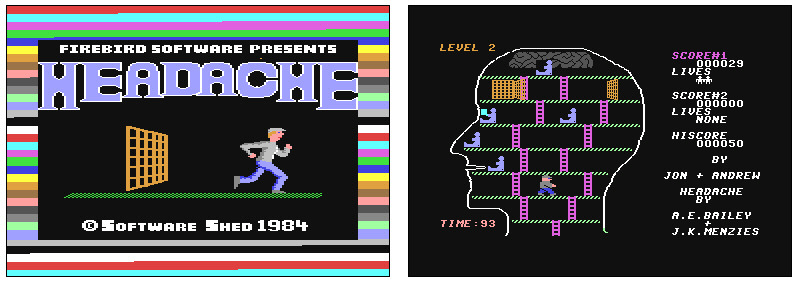
Headache's loading screen
(left) and second level (right)
GERM WARFARE
Firebird's HOT label was for games sold at a higher price, with distinctive red and yellow packaging that is now highly collectible. GERRY THE GERM GOES BODY POPPIN' had an unusual protagonist, in the form of Gerry - a bright green germ with googly eyes. There were six separate screens representing parts of the body and the aim in each was to cause as much trouble as possible, raising the host's fever. However, should Gerry fail or be hit by enemies he would be returned to the first screen to start again. In the lungs Gerry must grab the oxygen to reduce their function. Moving on the kidneys, Gerry's row boat is chased by a bull so he must grab the toilet roll to block up the flow and stop the bull for a while. The kidneys screen sees Gerry eating kidney beans, while the bowels sees him avoiding toilet plungers. The stomach task has Gerry dissolving Mr. Aspirin with a bottle of acid while the pancreas (St. Pancreas, in a pun on the famous London railway station) uses a train driver metaphor as Gerry infects medical supplies. The final location is the heart, where Gerry must avoid anti-bodies and infect this most important organ.
The game is best remembered for its Rob Hubbard soundtrack consisting of several jolly tunes - because it does become very repetitive, and the graphics are not very exciting. It was re-released on budget price, where it was better value for sure. The original ZZAP rating was a lowly 39%.
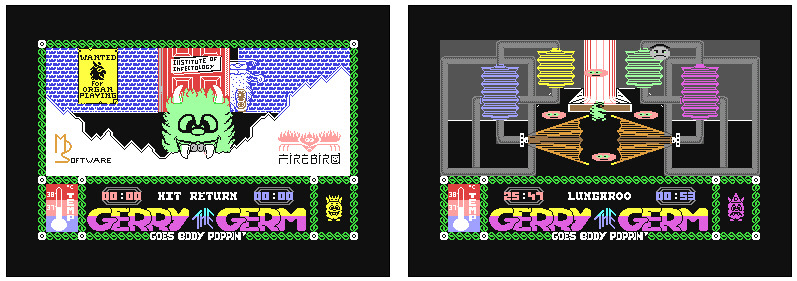
The title screen (left)
and opening level of Gerry the Germ, where he must grab oxygen from the
lungs (right)
I'VE GOT YOU UNDER MY SKIN
DNA WARRIOR from Cascade is very heavily influenced by the films mentioned in the introduction of this article. Professor Szymanski has accidentally injected raw DNA into his brain and it is growing out of control. In a miniaturised submarine, the player must seek out eight parts of a Growth Inhibitor. Unfortunately the professor's immune system will react to the sub and send waves of anti-bodies and mutant cells to attack. Killing a complete wave reveals a useful plasma sphere, which can be used to activate extra weapons (by pressing Space when the required weapon is shown in the score panel). One sphere gives a speed-up, two awards rapid fire, three activates vertical fire and so on up to seven spheres - which replenishes the energy bar. Flying through the horizontally scrolling levels, there are junction points to take; some are locked requiring the player to find a key. Finally the player must reach the brain and take on the implanted DNA to save the professor.
As shoot 'em ups go, this is quite good. Graphics are above average with some nice touches (like the flying blood cells). Sound is OK, with a nice title tune and pleasant sound effects. The big gameplay problems stem from working out where the junctions are onscreen as colliding with scenery drains energy. With a bit more variety in play this could have been very good, but it falls short - as seen in its ZZAP rating of 74%.
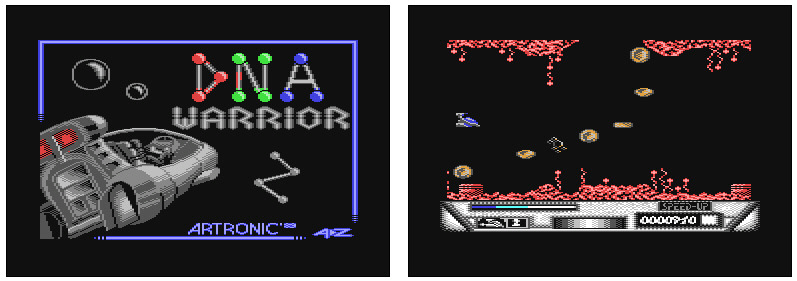
The loading screen of
DNA Warrior (left) and red blood cells attacking the submarine (right)
THIS TAKES GUTS
A different sort of anatomy was on show in GUTZ, developed by Special FX and published by Ocean Software. A giant alien monster is threatening Earth, and so a lone fighter is sent inside the alien to stop it - by destroying its major organs. Each level is a maze of cell walls viewed from a tilted overhead perspective, with the player needing to find a key and three parts of a super-weapon. Enemies swarm at the player, so it is good that extra firepower can be picked up from blisters on the cell wall. (There are several types of firepower, each with its own strengths and able to cause damage to specific enemies). Reaching the end of a maze sees the player enter a vein to move around the alien body, shown side-on. The enemies continue to attack here. After every three mazes are completed there is a major organ (kidney, lungs, heart and brain), which must then be destroyed by depleting its energy bar with the assembled super-weapon. Extra help comes from finding special items. Crystals give rapid fire for three minutes, the helmet protects against bullets and gas, and a mapping unit allows the player to see the layout of the current section.
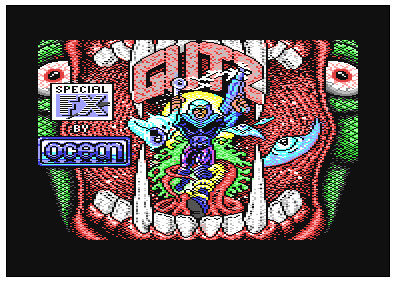
The loading screen of
Gutz
The graphics and sound of Gutz are pretty good, with some nice enemy sprites and a good overall theme. However, it does become repetitive after a couple of levels and despite the map it is easy to wander around in circles. It gained a disappointing 51% rating from ZZAP.
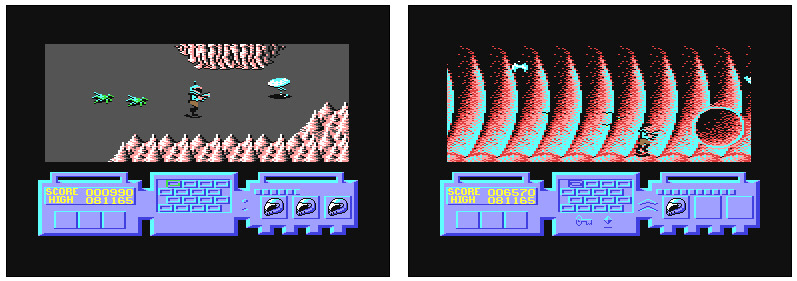
Overhead maze level (left)
and a side-view of a vein from inside the alien monster in Gutz (right)
LEARNING MACHINE
Among the educational titles that featured the human body were the HUMAN ANATOMY SERIES by SM Thorpe, which started with the SKELETON BONES TUTORIAL. THE BODY IN FOCUS from CBS Software looked at many areas of the body, while THE BODY TRANSPARENT (by DesignWare Inc. and re-released by Britannia Software) tasked players with placing bones and other vital parts onto a diagram of a body. Finally the LADDERS TO LEARNING series from McGraw Hill included BONES AND JOINTS.

Close-up of the skin
from The Body in Focus (left) and placing the scapula in The Body Transparent
(right)
FURTHER PLAY
This column has to also mention U-91306 EIDOTHEA, developed by Errazking using the Sideways Shoot ‘Em Up Construction Kit. This is very much like Fantastic Voyage, and cleverly includes X-ray maps and a syringe injecting the player's ship into the body. The classic Intellivision game MICROSURGEON is worth trying, with its colourful and highly stylised graphics standing out.

The tiny sub is injected
at the start of U-91306 Eidothea (left), Inside the head - a view from
Microsurgeon (right)

Closing an incision in
Life & Death (left), Using motion controls in the Wii game Trauma Center:
New Blood (right)
There was an Amiga, Apple II and DOS game
called LIFE & DEATH all about being an abdominal surgeon, and
of course modern PC users can try that with the successful SURGEON SIMULATOR
series. The Nintendo DS and Wii played host to the TRAUMA CENTER
series, making good use of the touchscreen on the portable machine and
the Wii's motion controls.
|
What's up everyone? I missed writing for last issue due to a very busy schedule. I just had a lot of stuff going on and writing slipped my mind. The month of December 2017 has been very busy as well and its taken me a while to get going to write for this issue. But like in the past, sometimes the best ideas come when they are at the last second!
The topic of discussion this issue is Star Wars! Now this topic would hardly be related to the Apple II BUT I found something to make it relevant. I'll share at the end. Otherwise, with the release of Star Wars: The Last Jedi, it would be a great time to discuss my gaming experiences related to various Star Wars games throughout the years. This actually encompasses a wide variety of systems I have written about previously in Retrogaming Times Monthly (Atari, PC, Mac).
As with most, my first Star Wars game was in the video arcades in the 1980’s. The game was affectionately know as just Star Wars but I've seen references to Star Wars: The Arcade Game. In this game, you take the role of Luke Skywalker and pilot his X-Wing against TIE Fighters, through some stationary objects and finally down the trench ala "A New Hope" where you hopefully blow up the Death Star and then you attempt to repeat the process. However, the second time around, the speed and number of TIE Fighters increase and even Darth Vader's TIE Fighter makes an appearance. If you get past this to the second part, the stationary objects have been replaced by gun towers. Lastly, if you get the the trench, there is many more obstacles and cannons against you. I recall getting past the second level a few times but the 3rd level was challenging. I don't think I ever got past the 3rd level.
After playing Star Wars in the arcade, I don't recall playing many of the other games that were available in the arcades or at home (including Empire Strikes Back and Return Of The Jedi). However, at some point, I did pick up Atari 5200 version of Star Wars: The Arcade Game. My recollection was that I picked it up toward the end of the Atari 5200's life, perhaps at a close out sale or something. It was a surprise as I didn't remember that Star Wars had been released for the Atari 5200.
I don't remember much of the Atari 5200 version of the game besides that the graphics and sound were much weaker (obviously) than the arcade version. In fact, I just tried to boot up Star Wars on my Atari 5200 emulator and the game loaded but I couldn't play it for some reason.
As I went to college, Star Wars games made a revival, potentially due to the release of Timothy Zahn's book Heir To The Empire in the 1990's. I recall the games X-Wing and TIE Fighter being released. As a fan of flight simulator / flying action games (ala Skyfox / F15 Strike Eagle), X-Wing was great fun on my Windows 95 PC / Windows 98 laptop. I played it for a while though I don't think I ever finished all the missions. I picked up TIE Fighter at some point but never played it.
Just like in my youth, after X-Wing I never played any Star Wars games even though many first person and other types of games came out. I actually spent a great amount of time reading the various Star Wars novels that were released.
But a few years ago, another Star Wars game caught my attention. It was called Star Wars: Empire At War. Unlike most of the games I had played previously , this was a strategy game like Command & Conquer (which I like a lot). Interestingly, Empire At War had been released quite a few years ago but I downloaded it and played for quite a time. Alas, I never did quite finish the game and it just sits on my Mac's hard drive these days. But when I did play it, it was quite fun. Maybe I'll finish it one day.
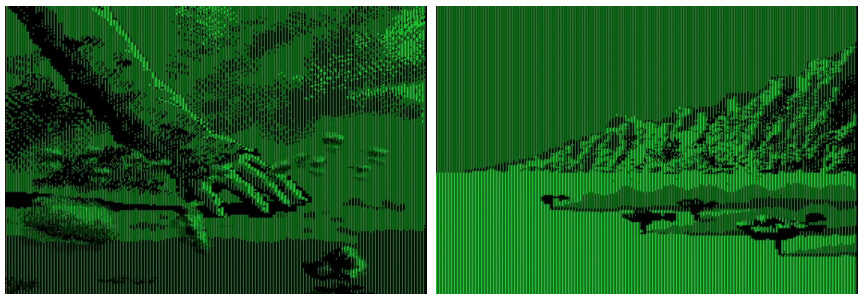
Stills from Wahyu Ichwandardi's
Star Wars: The Last Jedi Apple II trailer
That basically concludes my Star Wars gaming experiences. As The Last Jedi just opened a week before this writing, I promised I would tie this to the Apple II. As I was thinking about what to write for this column, I did a quick Google search on "Star Wars" and "Apple II." I found a few things including this:
Star Wars: The Last Jedi Trailer - In 8 Bit Apple II graphics format:
http://www.slashfilm.com/star-wars-the-last-jedi-8-bit-trailer-apple-ii-1984/
In the link, you see the Apple II version of the trailer and also the process the person took to create the trailer. WOW, just impressive. The Apple II "may be dead" but people still can do some work on the machine.
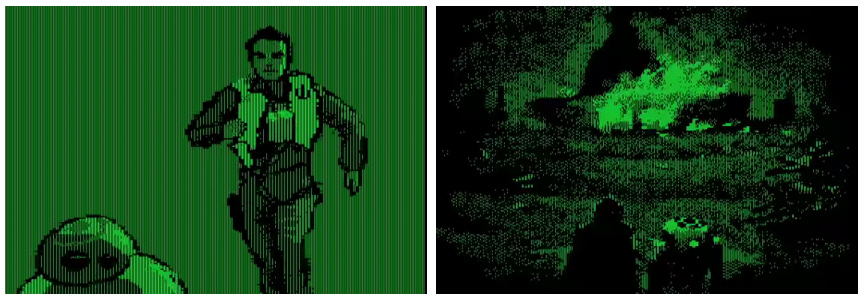
Stills from Wahyu Ichwandardi's
Star Wars: The Last Jedi Apple II trailer
Hope you enjoyed my experiences and the The Last Jedi Apple II trailer.
Have a safe and great holiday season and
see everyone ahead in 2018.
|
This issue we take a look at an underrated system that came out in America in 1989, when Nintendo and Sega were the top console players in the country, the TurboGrafx-16. This 16-bit system and revolutionary control pad made a valiant effort to be on top and in fact, some people still think the system is one the best from that era. We will discuss the control pad that came with the system along with some of the top games that still today are classics.
Most people would not know that the Turbografx-16 had an 8-bit CPU, but had a 16-bit video display controller, which made for some excellent graphics and gameplay for the late 1980's and early 90's. The company would try to do things different from their competitors by making changes to the standard game cartridges as well and the controller. Instead of the standard cartridge based games for the SNES and Sega Genesis, these games were flat card shaped and would slide into a slot to read the chips. Sega tried a similar approach years earlier with the Sega Master System but was unsuccessful.
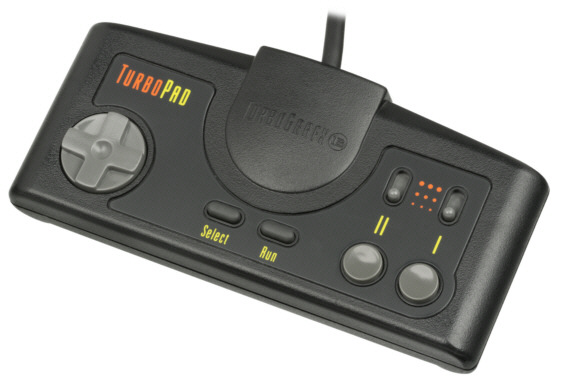
The controller for the Turbografx-16 is very unique, even to this day. The controller looks similar to the NES controller with the rectangular shaped pad and the two-button layout. The D-pad is similar as well but a little sleeker looking. The major differences, however, are the Run button, rather than the Start button. The buttons themselves, instead of A and B like the standard controllers, use I and II, plus they are a little beveled which makes for a nice feel when pressing the buttons. The Turbo switches above the buttons enhance the gameplay on certain games, allowing for rapid fire.

Bonk's Adventure (left
and center), Bomberman '93 (right)
One of most popular games on the TurboGrafx is Bonk's Adventure. This game was the system's way of recreating Mario and Sonic. Bonk was the character that you would move around and use to try to beat the different levels. Instead of coins, there are fruits and vegetables and instead of mushrooms and other known items for powerups, Bonk has to find different meats. The controls are pretty standard and easy to pickup quickly. The D-Pad is used to move Bonk around (left to right), and to control his spinning. While swimming or climbing, down will lower Bonk, but to move up, use up in conjunction with Button I. Up also allows Bonk to enter the skeletal elevators, and bonus entrances. Left and Right can be used to switch sides on the climbing levels like 2-6. Button I allows Bonk to Swim, Jump and Climb, while Button II allows Bonk to headbutt! When in the air, if you repeatedly hit this button, Bonk will spin. (You can hold it down if the turbo switches are in play). Overall this game is still one that people enjoy when they play the system.
Another Fun classic game is Bomberman '93. This game is much different than Bonk's Adventure. As with all Bomberman games, you will have to go through plenty of stages using bombs to kill enemies and collect items. The gameplay is simple, yet things can get difficult in the later stages of the game. The controls are easy: The direction pad moves the Bomberman around while Button I drops a bomb and the Button II uses multiple special items you collect along the way.
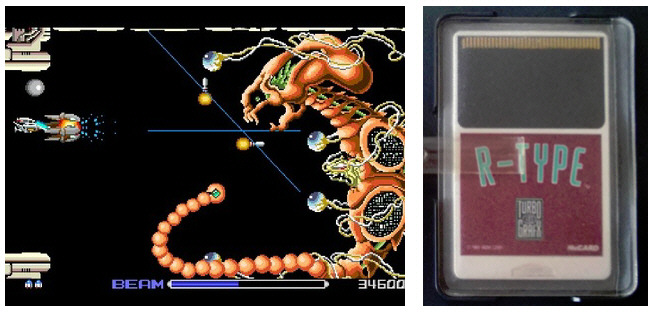
R-Type's most iconic
boss (left), R-Type on the TurboGrafx-16's HuCARD / TurboChip format (right)
One of my favorite games for the Turbografx-16 is R-Type. This side scrolling shooter game has fantastic graphics and gameplay. You will be confronted by all types of different creatures and obstacles, during eight different stages of game play. Defeat the aliens and restore peace to the galaxy while scoring as many points as you can along the way. The bosses are some of the most classic in the early generation shooting games. The Direction Pad will move your ship up and down and back and forth while Button II will shoot. You can use Button I to shoot extra power ups that come along as you defeat the aliens. When you capture your first laser capsule, an awesome weapon called the Force Pod appears. The Force Pod follows the path of the R-9 attack ship. By attaching the pod to the front or back of your ship, you can further increase your firepower. The pod also acts as a shield, protecting your ship from attack.
There was also a Turbo Stick controller
made for the system that tries to replicate the feel of arcade quality
controls. The buttons and controls are the same, the only difference
is instead of a D-pad you would have a joystick, similar to the arcade.
Overall, the Turbografx-16 was ahead of its time and really could have
been a contender for the console wars in America. I think what hurt
them the most is the limited selection of games and developers preventing
them from keeping up with Nintendo and Sega in the USA. I still love
to play this classic system and it bring back great memories of my childhood.
|
After much work, the long anticipated Newsletter Legacy Archive at The Retrogaming Times is currently live. This is a collected archive of every issue of Retrogaming Times, Bit Age Times, Retrogaming Times Monthly, and The Retrogaming Times in .PDF file format, ready for direct download. That's over 200 total issues across more than 20 years and we're still going!
The Newsletter Legacy Archive can be found on the main newsletter index at http://www.classicplastic.net/trt.
Retrogaming Times, Bit Age Times, and Retrogaming Times Monthly each feature single download links to obtain every issue in each respective newsletter in one file. Issues of The Retrogaming Times will have .PDF files added to the Legacy Archive as they are published.
I ask that anyone browsing the archive please take a moment to read the formatting information on the Legacy Archive page so you understand exactly what you are downloading, as most issues will have download options for two different layout configurations. Additionally the entire archive is backed up, offline, in three locations. There is no need to stash the whole thing away or redistribute it elsewhere. In fact I ask that the archive not be redistributed at all, so that any updates or fixes will always take place at the top.
If anyone notices any problems, links on the directory that don't go anywhere or point to the wrong file, please contact me using the e-mail contact on the Legacy Archive page.
It is the hope that this archive will allow every issue of the "Retrogaming Times" newsletter lineage to be enjoyed for many more years to come.
Thank you all very much for your patience
while this undertaking was completed and thank you for reading The Retrogaming
Times.
|
It was 1990 or 1991. I didn't have any video game consoles at home, because they were too expensive for my parents, as they were for most families in my home country, Brazil. My gifts used to be the smallest of LEGO sets. I loved them, but I also wanted to play those games whose pictures covered the most interesting children's magazines of the time.
My uncle, who lives in a city far from mine, bought a Sega Master System for his daughter, my cousin. Then grandpa took me to their home in a magical January. And how magical it was! From first looking at those checkered boxes, to opening them and reading the booklets with such interesting stories, to continuing those stories on TV, sometimes helped by my uncle himself. Everything was so spectacular, that every December onwards I started becoming sick with anxiety, to the point that even the food I ate refused to stay in my stomach - only because I couldn't wait to travel and see what new games my uncle had acquired.
This situation endured until 1995, when my grandma finally gave me my own console, a brand new Master System III Compact with Sonic the Hedgehog pre-installed in its BIOS. Today, I have a huge collection of Tec Toy MS games and they're all very dear to me. I actually play them to this day and still have a lot of fun.
But you may be curious to know what were the first games I played during that first magical vacation. To tell you the truth, I can't remember either. But I do remember the games I enjoyed the most. They were: After Burner, Gauntlet, and Great Soccer.
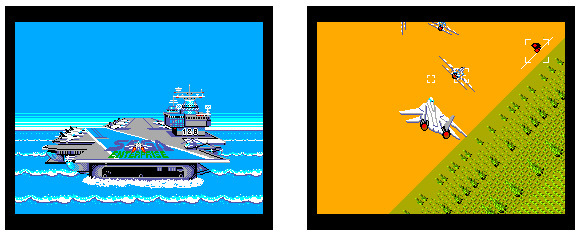
After Burner was a favorite because of its "feature" which lets you easily reach stage 10 by putting your airplane on the left corner of the screen, nose up. Maybe I'm mistaken, maybe the game doesn't have this many stages, but my memory says I've reached level 17 on the game.
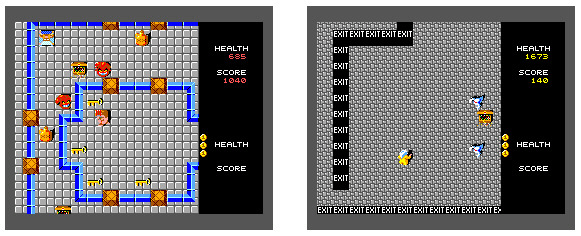
Gauntlet was good because I could play it with my uncle, and together we would wait 1 minute on the difficult stages, no touching the controllers, until all the walls became exits. We went pretty far into the dungeons by doing it. Again, I'm not sure if my memories aren't making a fool out of me, but I remember my uncle and me reaching level 114.
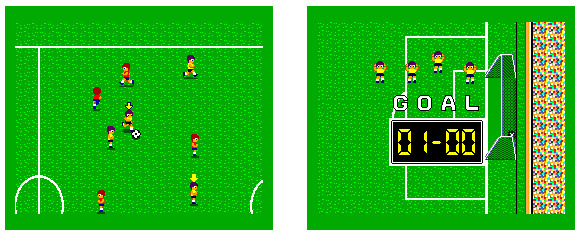
Great Soccer was good because, well, because I'm Brazilian and it's a soccer game. Most male kids here love soccer and soccer video games. I wasn't a good player on this one. My victories, in the rare instances when they happened, were only by one goal. I wouldn't beat any opponent by 2 - 0 until I was much older.
Later, I became enamored with more complex
games - platform games like Sonic and Mickey. But if these three
classics weren't there, who knows if I would become the Sega-maniac adult
that I am today.
|
While not technically totally exclusive to the Xbox, TRON 2.0 Killer App is a console-centric rework of TRON 2.0, originally released on PC about a year prior. At the time of its release, the story treatment for TRON 2.0 was considered to be the official sequel to the 1982 feature film TRON. Taking place years after the events of the original film, the player is given the role of Alan Bradley's son, Jethro "Jet" Bradley. Alan is still an employee at ENCOM and wants his son to join him at the company to assist him in his digitizing research. However another company called fCON, who seems to have shady motives, has recently acquired ENCOM and their digitizing facilities. Agents of fCON kidnap Alan, prompting his AI system Ma3a to digitize Jet into the world of the computer. An fCON executive has been improperly digitized into the network, corrupting him into a virus, and wreaking havoc throughout the system. Jet begins his journey to get to the bottom of fCON's plans, discover the whereabouts of his father, and attempt to restore the system.
While a handful of TRON games had existed before, TRON 2.0 changed things up by presenting the action from a first-person perspective. Essentially this boils down to a conventional first-person shooter set in a computer system as seen in TRON. As in the film, a program's primary tool for offense and defense is their identity disc. The disc can be thrown like a Frisbee and will return to the thrower after exhausting its movement or being manually called back. It can also be held up to defend against other discs or projectiles and as was seen in the film, a good strategy is to deflect an enemy disc and then throw yours before they can recover theirs. In addition to the standard identity disc, there are a number of different weapons that all conform to the standard FPS arsenal, although all of them have been visually reworked to fit into the TRON vision of a digital world.
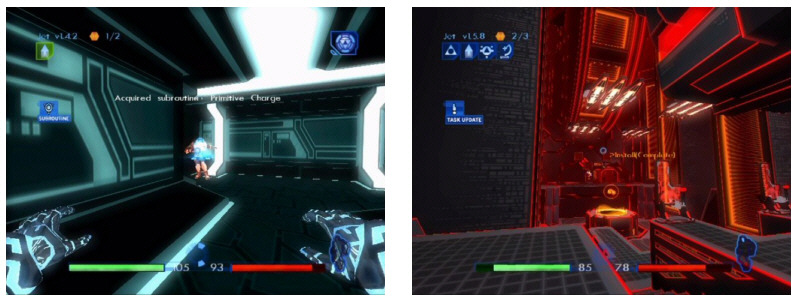
Jet attacks a guard with
his identity disc (left), the visuals of TRON are recreated wonderfully
(right), images courtesy MobyGames
That vision is where TRON 2.0 Killer App really shines - or is that glows? An outstanding job has been done to make the game look like the world of TRON. Hard angles, shimmering pools, glowing towers, light and contrast, weapons that leave streaks of energy behind them - I have to give the developers credit in really nailing what makes TRON look like TRON. I especially love the muted "boing, boing, boing" sound that your footsteps make, even though you'll probably want to use an upgrade to dampen the sound for more stealthy movement. Obtaining and deciding how to best use stat upgrades is also integrated into the vision of the computer world as presented in TRON. Upgrades and enhancements are downloaded via data bins that require permissions to access. Downloading more advanced applications requires more time and energy, as the files are larger. Everything from abilities to armor enhancements to weapons are obtained and upgraded in this way. Additionally e-mails can be downloaded through this same method and serve to tell the bulk of the backstory for the entire game. Each area of the system has different memory requirements, forcing the player to decide what upgrades and weapons to outfit Jet with. Everything can be upgraded twice, each time becoming more efficient and taking up less memory, allowing Jet to have a larger arsenal or better tools at his disposal. Additionally a number of preventative applications can be equipped in this way, such as virus shields and scanning abilities that make the digital life a little easier for Jet. The pick-and-choose system of fitting equipment subroutines into available memory slots is a cool concept, and a uniquely TRON spin on an action RPG standard, but the menu system for it is extremely clunky. Occasionally I would mangle something I had previously set up to my liking, only to have to back out and clear Jet's memory completely and set it all again. Throughout the entire game I would have this issue from time to time, as it can be difficult to realize what part of the submenu is currently selected.
While this may all sound spectacular to a TRON fan and seem like something different from other games played from the first-person perspective, Killer App really can't completely shed the genre in which it fits. The majority of the game is spent following standard first-person shooter conventions such as eliminating all the enemies in the area, finding ammunition (weapon energy), obtaining keys (access permissions), upgrading weapons (subroutine versions), and moving from point to point. The coat of fluorescent paint that Killer App throws over the FPS formula may be beautiful but at the end of the cycle it's still a visually unique first-person shooter and not much more. Platforming sequences were added for the Xbox version and while jumping from the first-person perspective isn't terrible, it can be difficult to judge distances and bumping your head into an object or sliding off a platform happens more than it should. Weapon and ability upgrades are often placed in areas that require precise jumping from cube to cube where a single slip-up means instant death. There were also a few areas where I walked directly of a ledge, as it was hard to discern where a platform ended and a crevasse began.
My biggest complaint with Killer App has to do with the identity disc weapon and how it doesn't work as it should. Technically Jet should be able to throw it with a curve so it'll bend around corners and can be used while taking cover. However this motion is directly tied into the control for positioning Jet's perspective, meaning the disc has to be thrown as you are turning away, making it impossible to hit anything. The disc also has a tendency to get hung up on the terrain in the distance, often becoming unresponsive to the manual return command. Disc battles against enemy programs should be the highlight of the game however enemies don't make any noise when they attack in this way. This means Jet can walk into an area and immediately begin to get pummeled without knowing where the attack is coming from. There are simply no audio or visual cues to denote this, other than quickly looking around to see if you can catch a weapon beam moving across the screen. Nothing killed me more when playing this game than to get completely obliterated by patrolling laser drones that were too far in the distance to be seen, let alone attacked. The silence of enemies also robs any satisfaction of destroying them, as they derez without any audio effects. Interestingly the lack of audio when battling enemies seems to be a result of the conversion to the Xbox platform, as the earlier PC version featured audio for all these events, including the trademark TRON derezzing sound. Even though the music in the game is very solid and much in the style of the classic TRON soundtrack, with the abysmal sound effects I have to say the over all audio package in Killer App is a tremendous disappointment.
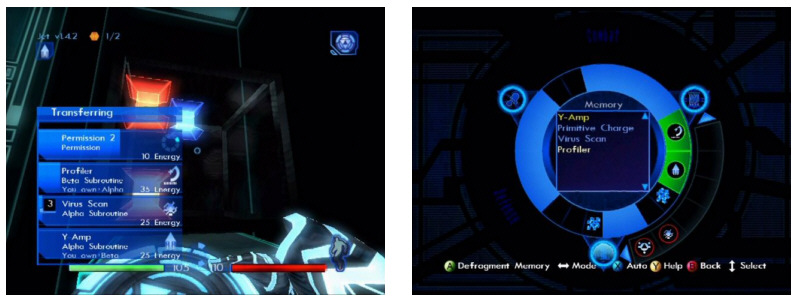
Downloading a permission
and subroutines (left), installing subroutines into available memory (right),
images courtesy MobyGames
There are also a number of technical issues with the game that may be a result of a hurried conversion for the Xbox hardware. Right out of the gate the load times are some of the longest you'll find on the Xbox and the loading screens are extremely frequent. Even if installed onto the internal hard drive of a soft-modded Xbox for the shortest possible load times, the loading screens break the gameplay up too much to be acceptable, regardless of the game's visual design. Additionally there are a few places where the frame rate of the game simply chokes. The worst of these is an area that takes place inside a firewall. While the visuals in that area are extremely interesting, the game runs so slow it feels like it's about to lock up the entire time, which makes completing the area's task complete chore. In addition to the platforming issues there are also occasional bouts of terrible collision detection, such as falling through small cracks in the floor or getting hung up on terrain. I also found the lightcycle sequences to not only be unentertaining but overly frustrating due to the way the camera perspective seems to forget how it is set. I know back when TRON 2.0 and Killer App were released the lightcycle sequences were praised but they simply don't control smoothly enough to be enjoyable. It's no wonder that the option to skip them without penalty is offered upon the very first failure.
While Bruce Boxleitner reprises his role as Alan Bradley and Cindy Morgan (who played Lora Bradley) voices his AI program Ma3a, the story itself ultimately doesn't go anywhere. At the outset of the game it's stated that Lora was fatally wounded in a lab accident when a digitizing laser misfired. So much time is spent in-game reading e-mails and learning about the backstory of Ma3a, and how things seem to be lining up for some big reveal that Ma3a is actually Lora digitized into the computer world. However this ultimately never happens and the entire narrative simply stops before any real payoff. The motives of fCON acquiring ENCOM so that they can distribute digitized human hackers known as Datawraiths, eventually comes across as something out of a Scooby-Doo episode, complete with bumbling henchmen that serve as the game's final digitized monster. With the abrupt ending I can see why the TRON 2.0 treatment that became this game never got far enough along to be made into a feature film. While I was very invested in the story, most of it told through the e-mails discovered in the computer world, it simply doesn't come to any sort of satisfying result. The game simply ends after the conclusion of a boss fight, forgetting the narrative and going full tilt into conventional first-person shooter video game clichés.
It should be said that the 1982 feature
film TRON is my all time favorite movie and has been so for much of my
life. While I don't consider it the greatest film ever made, it has
always been the film I enjoy most. I may sound overly critical when
commenting on TRON 2.0 Killer App but that's because it gets so close to
being an outstanding sequel story and a fulfilling game. Many of
the shortcomings such as the load times, collision issues and missing audio
could have been corrected with a little extra development time for the
Xbox conversion. It's also always a treat to see or hear Bruce Boxleitner
in a TRON production and the voice work throughout the game is outstanding.
Yet I dislike this game for presenting interesting story concepts, such
as the fate of Lora Bradley and creation of digitized hackers, without
having any sort of real conclusion other than a staff roll. Is TRON
2.0 Killer App worth playing? If you're a fan of the TRON franchise
and can get past the extreme loading times then this game is at least worth
a shot. There are moments where TRON 2.0 Killer App genuinely shines,
such as an area filled with the tanks from the original film that takes
place in an older system, but these moments aren't as frequent as I feel
they should be. The margin of difference may be slim but Killer App
sadly irritates more than it entertains.
|
Every Friday on The Retrogaming Times Facebook page (facebook.com/theretrogamingtimes), we present a Weekly Retrogaming Trivia question. This just-for-fun trivia challenge provided each week is an opportunity to test your arcane and oddball retrogaming knowledge. The answer to the question from the previous week is posted along with a new trivia question every Friday!
Below is the recap of all questions and
answers posted between this issue and the previous issue:
10/27/2017 - WEEK 38
Question: What is the
name of the criminal organization Joe Musashi battles against in the 1987
arcade game Shinobi?
11/03/2017 - WEEK 39
Question: What was the
first original (not previously released on cartridge) game released on
the Famicom Disk System?
11/10/2017 - WEEK 40
Question: In its prototype
stage, what was Dr. Mario originally titled?
11/17/2017 - WEEK 41
Question: Prior to being
renamed when released by Atari Corp., what was the original name of the
Lynx handheld when under development at Epyx?
11/24/2017 - WEEK 42
Question: What was the
final game featuring Sonic The Hedgehog to be released on the Sega Genesis?
12/01/2017 - WEEK 43
Question: Where and
when does the first stage in the 1989 arcade game Strider take place?
12/08/2017 - WEEK 44
Question: What building
is pictured as the backdrop on the cover art of the original Grand Theft
Auto?
12/15/2017 - WEEK 45
Question: What was Capcom's
final Sega Saturn release?
12/22/2017 - WEEK 46
Question: What 1982
arcade game features a damsel in distress named Zelda?
12/29/2017 - WEEK 47
Question: What is the
only Christmas themed Famicom Disk System game?

The introduction to Strider
(left), two different prototype builds of Dr. Mario as Virus (right)
Answers:
Week 38 Answer: Zeed.
Week 39 Answer: Zelda no Densetsu:
The Hyrule Fantasy (The Legend of Zelda).
Week 40 Answer: Virus.
Week 41 Answer: Handy, sometimes
referred to as Handy Game.
Week 42 Answer: Sonic 3D Blast (1996).
Week 43 Answer: Kazakh Soviet Socialist
Republic, 2048.
Week 44 Answer: Trump Tower.
Week 45 Answer: The Japan exclusive
release of Final Fight Revenge (2000).
Week 46 Answer: Taito's now in-demand
classic, Zoo Keeper.
Week 47 Answer: Santa Claus no Takarabako.
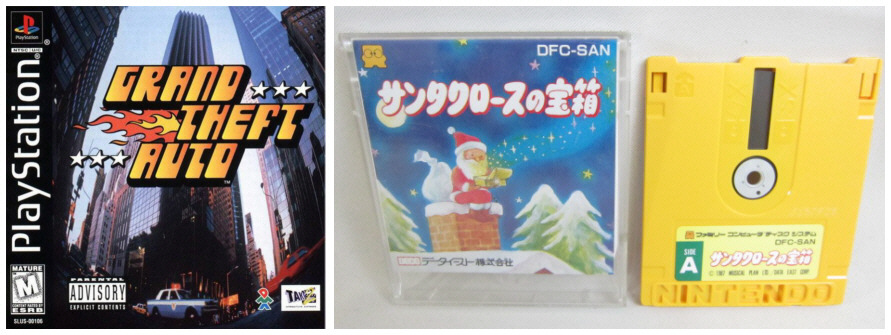
Trump Tower on the cover
of Grand Theft Auto (left), Santa Claus no Takarabako for the Famicom Disk
System (right)
Don't be left out! Be sure to follow The Retrogaming Times on Facebook for a new retrogaming trivia question every Friday!
We need your questions! If
you have a trivia question you would like to submit for possible inclusion
in the Weekly Retrogaming Trivia question pool, e-mail it to trt@classicplastic.net!
If you question is selected to be featured, you will be entered in our
year-end prize drawing!
|
Thinking about the release of the TurboGrafx-16 in North America brings to mind how differently video game history plays out depending on region. While there are still differences between regional console launches to this day, they are nothing compared to how things were in the 1980's and 1990's. The Nintendo Famicom is always a good example of this, as while the Nintendo Entertainment System is looked at as a powerhouse of late 80's and early 90's gaming, the original Japanese version of the hardware premiered way back in 1983. Granted the home video game market of the time in the United States was in rather poor shape due to essentially collapsing under its own weight, so a delay and a redesign of the Famicom into the NES made perfect sense. On the other hand, the decisions that lead up to the launch of the TurboGrafx-16 stateside made little sense at all. The partnership of NEC and Hudson to co-produce a home video game console resulted in creation of the PC Engine, what the TurboGrafx-16 was known as in Japan. PC Engine went on sale in Japan in October of 1987, a full year before Sega's Mega Drive (later released as Sega Genesis in North America) appeared on shelves and three years before Nintendo released their Super Famicom (later released as Super Nintendo in North America). In essence, NEC and Hudson had a tremendous head start on the next generation of video games. The PC Engine was tremendously successful in Japan, outselling the Famicom in 1988 and for a time becoming the most popular video game system in Japan. Heck, by December of 1988 NEC already had a CD-ROM expansion for the PC Engine on Japanese store shelves.
There are a number of reasons to consider as to why the success of the PC Engine in Japan didn't translate to the same with the TurboGrafx-16 in North America. However if I could pick a single one to point to, it would be timing. While PC Engine launched in Japan in October of 1987, TurboGrafx-16 wasn't available until August of 1989 and was initially only marketed in large population centers in California and New York. Additionally after Sega failed to make much headway in Japan with the Mega Drive, they decided to go all-in on the North American market, launching the Mega Drive as Genesis two weeks before the TurboGrafx-16. By the time TurboGrafx-16 had widespread availability, NEC found itself the odd man out among the massive installed base of the NES and the outstanding marketing of the Genesis. Once Super Famicom arrived in North America as Super Nintendo two years later in 1991, the hope of any mainstream success for NEC in North America was over. NEC forfeited a huge opportunity, one that would have possibly radically changed not only the future of Hudson Soft but the future of video games entirely. Then again, the PC Engine project was only a small portion of NEC's extensive business holdings. Hudson didn't seem to care one way or another if the console was successful outside of Japan, as they received design royalties for every piece of hardware manufactured, regardless if it sold. It's sad but from the day TurboGrafx-16 launched, it seemed the only people who cared about it outside of Japan were the enthusiasts who loved the system and games, something that has persisted to this day. Perhaps I'll revisit the TurboGrafx-16's stumble out of the gate in more detail in a future issue.
Thank you once again for reading The Retrogaming Times. We'll be back on March 1st with our next issue. Be sure to follow The Retrogaming Times on Facebook and join our community for the latest updates and information! I sincerely hope you enjoyed this issue and that you will return to read the next issue and possibly submit an article yourself. Remember, this newsletter can only exist with your help. Simply send your articles directly to me at trt@classicplastic.net or check out the submission guidelines on the main page. Submit an article today and join a great retrogaming tradition!
See You Next Game!

Content and opinions on this
page are those of their respective writer(s)
Assembled and published
by David Lundin, Jr. on January 7th, 2018 at ClassicPlastic.net
© 2018 The Retrogaming
Times. All Related Copyrights and Trademarks Are Acknowledged.